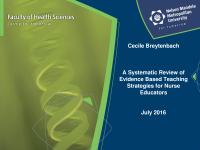Using evidence-based teaching to support an innovative teaching strategy in an undergraduate research course: A longitudinal study
View File(s)
Visitor Statistics
Visits vs Downloads
Visitors - World Map
Top Visiting Countries
| Country | Visits |
|---|
Top Visiting Cities
| City | Visits |
|---|
Visits (last 6 months)
Downloads (last 6 months)
Popular Works for Wilson, Astrid H. by View
| Title | Page Views |
|---|
Popular Works for Wilson, Astrid H. by Download
| Title | Downloads |
|---|
View Citations
Citations
Session presented on Monday, November 9, 2015:
Purpose: This longitudinal study was aimed at providing evidence-based teaching for an innovative teaching strategy in an undergraduate research course.
Method: A longitudinal survey design was used to elicit students' responses about an assigned group project. The instrument used was the Evidence-Based Group Assignment Survey, a 21 item Likert type survey developed by the author. The responses were strongly disagree (1), disagree (2), somewhat agree (3), agree (4), and strongly agree (5) thus a summated score could be obtained between 21 and 105. The items related to how the assignment helped students gain knowledge, skills in critiquing research articles, making decisions related to evidence-based practice, and confidence in themselves to be better prepared to participate in evidence-based activities as an RN. The survey was administered at the end of eight separate research classes from 2008 to 2014. IRB approval was obtained for this research study. The innovative teaching strategy will be described so it can be used by other educators.
Results: The sample consisted of 225 undergraduate nursing students who were predominately traditional students, with some accelerated students and few RN-BSN students. The majority of the participants were female (96%) and 90% were traditional students. The mean summated score for all groups (225) ranged from 78 to 93. The mean scores on each item on the instrument ranged from 3.89 to 4.62 (out of 5) indicating that no means were in categories of disagree or strongly disagree. Internal consistency of the instrument was established using a Cronbach's Alpha for each group. The alpha score for the entire sample was .94 (very high).
Implications: There is a continuous need to determine teaching strategies that have an evidence-based teaching practice. The Evidence-based Assignment in this study has empirical support for its use. Students can gain more knowledge of evidence-based practice in nursing courses with innovative strategies with evidence support. With evidence-based teaching practice clinical settings will have new graduates who are better prepared to identify clinical problems needing evidence, locate, understand, and critique research articles and systematic reviews. Students also will be better able to participate in evidenced-based projects in the clinical setting which is especially important in agencies seeking Magnet status.
43rd Biennial Convention 2015 Theme: Serve Locally, Transform Regionally, Lead Globally.
Items submitted to a conference/event were evaluated/peer-reviewed at the time of abstract submission to the event. No other peer-review was provided prior to submission to the Henderson Repository, unless otherwise noted.
| Type | Presentation |
| Acquisition | Proxy-submission |
| Review Type | Abstract Review Only: Reviewed by Event Host |
| Format | Text-based Document |
| Evidence Level | N/A |
| Research Approach | N/A |
| Keywords | Evidence-based Teaching Practice; Nursing Education; Evidence-based Practice |
| Name | 43rd Biennial Convention |
| Host | Sigma Theta Tau International |
| Location | Las Vegas, Nevada, USA |
| Date | 2015 |
All rights reserved by the author(s) and/or publisher(s) listed in this item record unless relinquished in whole or part by a rights notation or a Creative Commons License present in this item record.
All permission requests should be directed accordingly and not to the Sigma Repository.
All submitting authors or publishers have affirmed that when using material in their work where they do not own copyright, they have obtained permission of the copyright holder prior to submission and the rights holder has been acknowledged as necessary.
Related items
Showing items related by title, author, creator and subjects.
-
A first look at undergraduate nursing students' knowledge of evidence-based practice using the evidence-based practice knowledge assessment in nursing
Wonder, Amy Hagedorn; Spurlock, Darrell R. Jr. (2016-03-17)Session presented on Friday, July 24, 2015: Purpose: The quantitative relationship between self-reports of competence and objectively measured performance is generally < r = .3 and in a striking number of studies, ... -
Teaching undergraduate nursing students: An innovative approach to answering clinical questions utilizing current evidence-based practice
Hurlbut, Jene' M.; Carrion, Judith (2016-03-21)Session presented on Tuesday, November 10, 2015: We were challenged with the redevelopment of a 3 credit undergraduate nursing research course into a two week time frame. This approach was supported by the University's ... -
A systematic review of evidence-based teaching strategies for nurse educators
Breytenbach, Cecile H. (2016-07-13)Session presented on Sunday, July 24, 2016: Teaching strategies in nursing education is of vital importance to promote an understanding of knowledge allowing nursing students to compare existing knowledge with new knowledge ... -
Outcomes of evidence-based practice education in bedside nurses: A qualitative study
Sparks, Laurie A.; Balakas, Karen A. (2012-01-04)Practicing nurses today are expected to incorporate best evidence in their care. Evidence-based practice (EBP) has become recognized as the gold standard of care, prompting many healthcare organizations to invest resources ... -
Development of teaching strategies to prepare future nurses' ability in evidence-based practice
Liou, Shwu-Ru; Cheng, Ching-Yu (2013-10-22)Session presented on: Tuesday, July 23, 2013: Purpose: Evidence-based practice has become imperative in clinical practice since it bridges up the gap between conducted research and clinical practice. Promote students' ...





